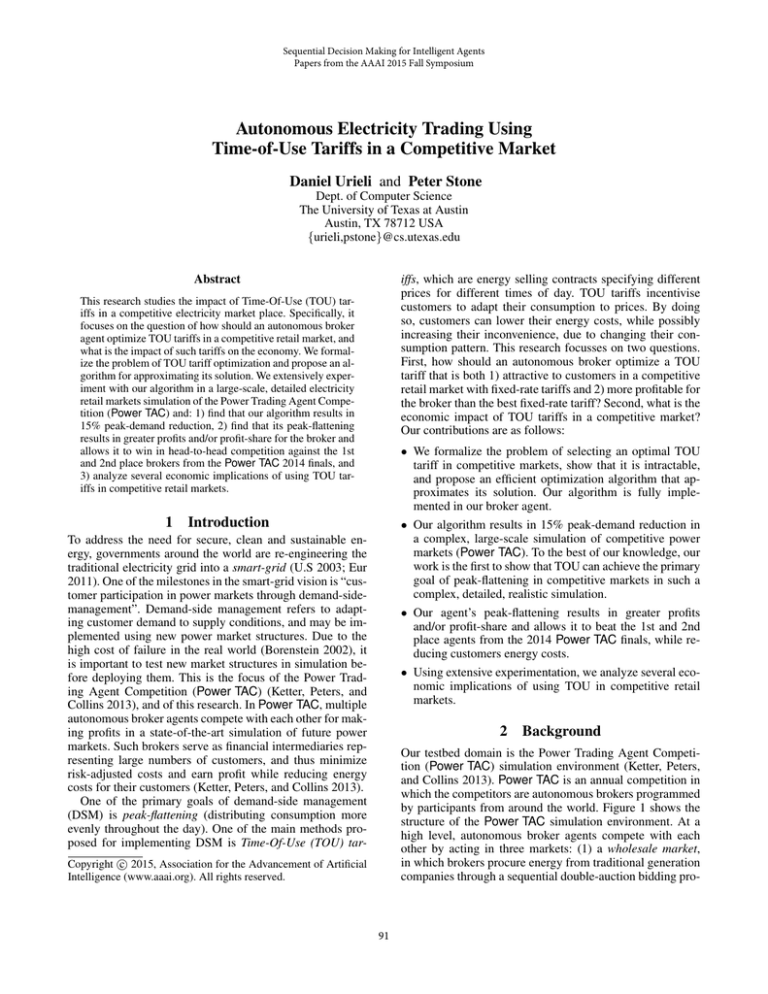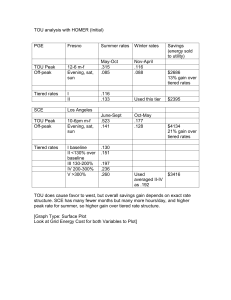
Sequential Decision Making for Intelligent Agents
Papers from the AAAI 2015 Fall Symposium
Autonomous Electricity Trading Using
Time-of-Use Tariffs in a Competitive Market
Daniel Urieli and Peter Stone
Dept. of Computer Science
The University of Texas at Austin
Austin, TX 78712 USA
{urieli,pstone}@cs.utexas.edu
Abstract
iffs, which are energy selling contracts specifying different
prices for different times of day. TOU tariffs incentivise
customers to adapt their consumption to prices. By doing
so, customers can lower their energy costs, while possibly
increasing their inconvenience, due to changing their consumption pattern. This research focusses on two questions.
First, how should an autonomous broker optimize a TOU
tariff that is both 1) attractive to customers in a competitive
retail market with fixed-rate tariffs and 2) more profitable for
the broker than the best fixed-rate tariff? Second, what is the
economic impact of TOU tariffs in a competitive market?
Our contributions are as follows:
This research studies the impact of Time-Of-Use (TOU) tariffs in a competitive electricity market place. Specifically, it
focuses on the question of how should an autonomous broker
agent optimize TOU tariffs in a competitive retail market, and
what is the impact of such tariffs on the economy. We formalize the problem of TOU tariff optimization and propose an algorithm for approximating its solution. We extensively experiment with our algorithm in a large-scale, detailed electricity
retail markets simulation of the Power Trading Agent Competition (Power TAC) and: 1) find that our algorithm results in
15% peak-demand reduction, 2) find that its peak-flattening
results in greater profits and/or profit-share for the broker and
allows it to win in head-to-head competition against the 1st
and 2nd place brokers from the Power TAC 2014 finals, and
3) analyze several economic implications of using TOU tariffs in competitive retail markets.
1
• We formalize the problem of selecting an optimal TOU
tariff in competitive markets, show that it is intractable,
and propose an efficient optimization algorithm that approximates its solution. Our algorithm is fully implemented in our broker agent.
• Our algorithm results in 15% peak-demand reduction in
a complex, large-scale simulation of competitive power
markets (Power TAC). To the best of our knowledge, our
work is the first to show that TOU can achieve the primary
goal of peak-flattening in competitive markets in such a
complex, detailed, realistic simulation.
• Our agent’s peak-flattening results in greater profits
and/or profit-share and allows it to beat the 1st and 2nd
place agents from the 2014 Power TAC finals, while reducing customers energy costs.
• Using extensive experimentation, we analyze several economic implications of using TOU in competitive retail
markets.
Introduction
To address the need for secure, clean and sustainable energy, governments around the world are re-engineering the
traditional electricity grid into a smart-grid (U.S 2003; Eur
2011). One of the milestones in the smart-grid vision is “customer participation in power markets through demand-sidemanagement”. Demand-side management refers to adapting customer demand to supply conditions, and may be implemented using new power market structures. Due to the
high cost of failure in the real world (Borenstein 2002), it
is important to test new market structures in simulation before deploying them. This is the focus of the Power Trading Agent Competition (Power TAC) (Ketter, Peters, and
Collins 2013), and of this research. In Power TAC, multiple
autonomous broker agents compete with each other for making profits in a state-of-the-art simulation of future power
markets. Such brokers serve as financial intermediaries representing large numbers of customers, and thus minimize
risk-adjusted costs and earn profit while reducing energy
costs for their customers (Ketter, Peters, and Collins 2013).
One of the primary goals of demand-side management
(DSM) is peak-flattening (distributing consumption more
evenly throughout the day). One of the main methods proposed for implementing DSM is Time-Of-Use (TOU) tar-
2
Background
Our testbed domain is the Power Trading Agent Competition (Power TAC) simulation environment (Ketter, Peters,
and Collins 2013). Power TAC is an annual competition in
which the competitors are autonomous brokers programmed
by participants from around the world. Figure 1 shows the
structure of the Power TAC simulation environment. At a
high level, autonomous broker agents compete with each
other by acting in three markets: (1) a wholesale market,
in which brokers procure energy from traditional generation
companies through a sequential double-auction bidding pro-
c 2015, Association for the Advancement of Artificial
Copyright Intelligence (www.aaai.org). All rights reserved.
91
national grid
where P is a vector of 24 hourly rates, and where UH (P )
is the expected-utility (profits) over some future horizon
H, predicted with a lookahead simulation using a transition
function model composed of future demand and cost-curves.
Equation 1 is an optimization over actions at a given state,
and should be executed continually as a part of the broker’s
lookahead policy, to adapt the broker’s actions in the tariff
market to the continually changing game-state.
Equation 1 provides a theoretical objective for solving an
autonomous broker’s TOU optimization problem. In practice, there are at least two main obstacles to solving this
equation. First, future demand and cost-curves are typically
unknown. Second, even if they were known, optimization
requires search in a non-convex, discontinuous space, which
is generally intractable. To address the first problem of estimating demand and cost-curves we use online learning from
game data, and use known statistical information about customers’ behavior patterns. To address the second problem,
we resort to finding a local optimum, designing an empirical
gradient-based optimization algorithm that uses the curvesbased lookahead as an objective evaluation. Our algorithm
outperforms well-known optimization algorithms.
We extensively evaluated our TOU algorithm in hundreds
of games. We compared its performance with two baselines,
one using fixed-priced tariffs, and one using a naive TOU
optimization. We showed that TOU tariffs can compete successfully with fixed-rate tariffs: using TOU tariffs, our agent
performs better than the top 2 agents of the Power TAC
2014 finals. It reduced peak-demand by 15% compared
with using only fixed-rate tariffs, increased its profits and/or
profit-share, and saved costs for all customers (including
competitors’). Interestingly, while past work warned against
TOU tariffs inducing customer-herding, our TOU optimization method did not exhibit such a phenomenon, due to
a combination of (1) our broker’s profit-optimization using predictive demand models leading to coordinated flattening, and (2) a smooth customer inconvenience metric.
This underlines a potential benefit of employing autonomous
TOU brokers in competitive power markets. In addition, we
have seen that a TOU broker’s customer share is an important factor in its ability to flatten demand: to be able to
counter-balance peaked consumption of fixed-rate brokers’
customers, it needs to gain large customer-share by creating
attractive TOU tariffs that are still profitable.
renewables
production
electricity
generation
companies
Balancing
Market
Wholesale
Market
Tariff
Market
Electricity
Grid
commercial/residential
consumers
competing
broker
agents
Figure 1: Structure of the Power TAC simulation
cess, (2) a tariff market, which is a retail market in which
brokers offer tariffs (energy-selling contracts) to which autonomous, utility-optimizing customers may subscribe, and
(3) a balancing market, which serves to ensure that supply
and demand are balanced at all times and to financially penalize brokers for any imbalance in their portfolios.
Typically, a peaked daily customer demand is much more
expensive to satisfy than demand that is flat throughout the
day, since energy-generation costs are sharply increasing
with the amount of generation. To reduce its own costs, a
broker may incentivise its customers to flatten demand by
publishing TOU tariffs in the tariff market. Here we define
a TOU tariff to be a tuple P := hp0 , p1 , · · · , p23 i, where
pt is the hourly rate in cents/kWh during hour-of-day t. In
general, simulated customers (represented by autonomous
agents) are willing to subscribe to TOU tariffs and shift their
consumption to save costs if cost-reduction (compared with
competing fixed-price tariffs) is large enough to offset the
increased inconvenience due to consumption-shifting.
3
TOU Tariff Optimization
Given the internal states of the simulator and competing
brokers, the broker’s energy trading problem is a complex
MDP with continuous high-dimensional states and actions.
However, since competitors’ states and parts of the simulator state are unobservable, the trading problem is actually a
POMDP. Nevertheless, we approximate the trading problem
as an MDP. To combat the curse-of-dimensionality we use
a lookahead policy to optimize trading quantities and prices
in the tariff and wholesale markets. In the lookahead policy, tariff and wholesale market actions must be optimized in
conjunction, to maintain low imbalance. Part of this lookahead policy is optimizing TOU tariffs.
We frame the TOU optimization problem in terms of demand and cost curves. Let the demand curve of tariff τ be the
function D : R → R that maps energy-selling prices to the
resulting energy demand from customers that will subscribe
to τ . Let the unit-cost curve be the function C : R → R that
maps an energy amount to the unit-price for which the broker is able to procure it in the wholesale market. We define
the TOU tariff optimization problem as:
P ∗ := arg max UH (P )
References
Borenstein, S. 2002. The trouble with electricity markets: Understanding california’s restructuring disaster. Journal of Economic
Perspectives 16(1):191–211.
European Commission. 2011. Communication: Energy Roadmap
2050.
Ketter, W.; Peters, M.; and Collins, J. 2013. Autonomous agents
in future energy markets: The 2012 Power Trading Agent Competition. In Proceedings of the Twenty-Seventh AAAI Conference on
Artificial Intelligence. AAAI.
U.S. Department of Energy. 2003. “Grid 2030” A National Vision
For Electricity’s Second 100 Years.
(1)
P
92


